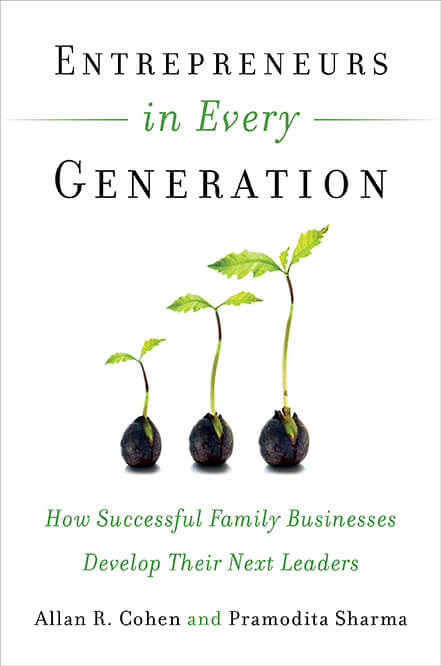
Book Review: Entrepreneurs in Every Generation: How Successful Family Businesses Develop their Next Leaders
By Allan R. Cohen and Pramodita Sharma, Berrett-Koehler, 2016
It isn’t often that a business book is both practical and fun to read. That is the rare treat of reading this new work by Allan R. Cohen and Pramodita Sharma, which explores what is probably the core challenge facing every family business as it seeks to build on its initial success.
This book challenges some conventional mindsets about family businesses, and these mindsets need to be challenged. For example, the idea has grown up that the creative act of the business founder has built the family wealth, and that thereafter, future generations must be dutiful sons and daughters, maintaining the wealth machine, not spending too much, but otherwise will not achieve much else. Yet, the reality is that no family enterprise that spans generations remains the same. The business itself adapts, develops and changes, and the family, to continue to build wealth, moves into more diverse areas. Today’s global business environment contains massive changes, and no family business can remain comfortably in its niche, unscathed by the pressures of globalization, competition, and technical innovation. The story of a family business is not a single act of greatness, but a series of innovations and new ideas, which are often unrecognized or under-celebrated because of the huge shadow cast by the business founder.
This wonderful book takes on two tasks that are not usually done well together. First, by searching the popular as well as the academic literature, it presents scores of stories of how families have passed the “entrepreneurship gene” to successive generations. We see how families have developed and nurtured new entrepreneurs, in many ways, in new generations. The research of the authors is not academic. Magazines like Tharawat and Family Business have presented family business innovation in many forms, business schools have created hundreds of case studies, and academic archives like that of the STEP family research project, serve as sources of data. The authors have plowed through all of these sources and extracted many powerful principles that they illustrate with the stories of real families. Cohen and Sharma have selected examples that show how families have developed as entrepreneurial organizations.
While they feature the innovations by talented individuals, they also show how the culture and policies create a family environment that encourages family members not to leave the family with their new ideas, but to stay and share them.
The second task taken on by the authors is to draw on assessment tools and skill development, to help guide a family in how they can support and develop this entrepreneurial environment. Cohen, a professor of entrepreneurship, who was one of the originators of the vast field of innovative leadership joins Sharma, who is a leader in family business scholarship, find a shared voice that synthesizes their different perspectives seamlessly. The book can be used by a family to take steps to promote an entrepreneurial environment or by a young and talented family member who is wondering if his or her creative energy can find a home in the family business.
The key concept of this book is one that is at the core of all successful organisations. It’s about how a business that has a strong and deep tradition—in this case, a family legacy of values and business practices—can also become a platform that enables renewal, resilience, and adaption as it faces new challenges and new generations discover new directions that can build upon the vital core legacy of the business family.









